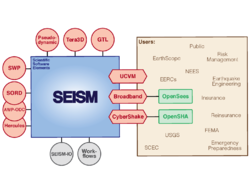Difference between revisions of "SCEC Software"
(Redirected page to SCEC Scientific Software) |
|||
| (29 intermediate revisions by the same user not shown) | |||
| Line 1: | Line 1: | ||
| − | + | #redirect [[SCEC Scientific Software]] | |
| − | SCEC | + | SCEC Community Modeling Environment [[CME Project]] researchers have developed a group of inter-related ground motion and seismic hazard modeling software tools that the National Science Foundation SI2 Project describes as a software ecosystem. Funding for this software development work comes from the National Science Foundation (NSF), W. M. Keck Foundation, Pacific Gas and Electric, and other funding sources. The links below provide access to the currently maintained SCEC open-source scientific software distributions. |
| − | + | [[Image:SCECSoftwareEcosystem.png|right|250px]] | |
| − | + | == Active CME Scientific Software Developments == | |
| − | |||
| − | |||
| − | |||
| − | |||
| − | |||
| − | |||
| − | |||
| − | |||
| − | |||
| − | |||
| − | |||
| − | |||
| − | |||
| − | |||
| − | |||
| − | |||
| − | |||
| − | |||
| − | |||
| − | |||
| − | |||
| − | |||
| − | |||
| − | |||
| − | |||
| − | == | ||
| − | [[OpenSHA]] | + | *[http://scec.usc.edu/internships/useit/scec-vdo SCEC-VDO] |
| + | *[http://www.opensha.org/ OpenSHA] | ||
| + | *[[Broadband Platform]] | ||
| + | *[[CVM-H]] | ||
| + | *[[CVM-S]] | ||
| + | *[[UCVM]] | ||
| + | *[[AWP-ODC]] | ||
| + | *[https://github.com/CMU-Quake/hercules Hercules] | ||
| + | *[[CSEP]] | ||
| − | [[ | + | == Active CME Scientific Software Platforms == |
| + | SCEC software development staff converts scientific software used by an individual research into scientific software used for community research. [[CME Project]] software developers integrate complex scientific codes together into larger computational systems that we call a [[Computational Platforms]]. Each SCEC computational platform is designed to reliably perform some useful or valuable research calculation. SCEC platforms include dynamic rupture, wave propagation, standard probabilistic seismic hazard calculations, and physics-based wave propagation simulations. In some cases, SCEC provides source code distributions of computational platforms for use by the SCEC community. | ||
| − | [[ | + | *[[CyberShake Project]] |
| + | *[[F3DT]] | ||
| − | [[ | + | == See Also == |
| − | + | *[[CME Project]] | |
| − | [[ | + | *[[SEISM Project]] |
| + | *[[SEISM2 Project]] | ||
| + | *[[Geoinformatics Project]] | ||
| + | *[[CyberShake Project]] | ||
| + | *[[High-F Project]] | ||
| + | *[[Main Page]] | ||
| + | *[http://www.scec.org SCEC Home Page] | ||
Latest revision as of 04:29, 12 September 2015
Redirect to:
SCEC Community Modeling Environment CME Project researchers have developed a group of inter-related ground motion and seismic hazard modeling software tools that the National Science Foundation SI2 Project describes as a software ecosystem. Funding for this software development work comes from the National Science Foundation (NSF), W. M. Keck Foundation, Pacific Gas and Electric, and other funding sources. The links below provide access to the currently maintained SCEC open-source scientific software distributions.
Active CME Scientific Software Developments
Active CME Scientific Software Platforms
SCEC software development staff converts scientific software used by an individual research into scientific software used for community research. CME Project software developers integrate complex scientific codes together into larger computational systems that we call a Computational Platforms. Each SCEC computational platform is designed to reliably perform some useful or valuable research calculation. SCEC platforms include dynamic rupture, wave propagation, standard probabilistic seismic hazard calculations, and physics-based wave propagation simulations. In some cases, SCEC provides source code distributions of computational platforms for use by the SCEC community.
